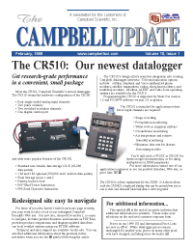The SC100 filters and buffers data between a serial sensor and a CR10(X) or 21X data logger. It is used in applications where the sensor transmits serial ASCII data asynchronously (i.e., a 4800 bps Global Positioning System receiver).
_x000D_The data logger uses Program Instruction 151 and control ports to read data sent from the SC100. P15 reads data stream transmissions at 300 and 1200 bps only. The SC100 buffers up to 90 bytes of serial data received at 1200, 2400, 4800, 9600, 19200 and 38400 bps then transmits the buffered data to the data logger at 1200 bps. The data (or commands) can also be transmitted from the data logger to the sensor when required.
_x000D_In the received data, the SC100 searches for a six-character, user-specified ASCII string (e.g., $GPGGA). It then buffers all data following the string until it encounters a termination character (e.g., carriage return). The SC100 and datalogger use control ports to coordinate data transfer; incoming data is placed in datalogger input locations to allow further processing or transfer to final storage.
A minimum of five sequential control ports are required to receive serial data. A seven-conductor cable is required to connect the data logger to the SC100 (the other two conductors are used for power and ground). The SC100 is powered by the data logger’s 5 or 12 VDC supplies; power consumption is 55 mA active, 50 µA quiescent.

